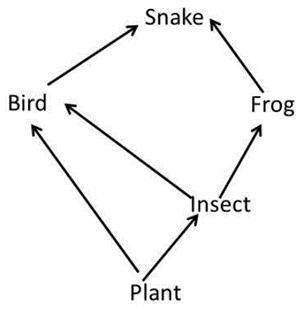
Biology, 16.10.2020 05:01 icantspeakengles
HELP WILL MARK BRAINLIEST.
Answer Q1-7 using the food web pictured below.
1. How many food chains make up the food web?
2. Which organism is an herbivore?
3. Which organism is an autotroph?
4. Which organism is a third-order heterotroph? To what trophic level does that organism belong?
5. Which organism is an omnivore?
6. Which organisms belong to more than one food chain?
7. Which organism belongs to more than one trophic level?
8. What are decomposers? From which trophic levels are the organisms that decomposers feed on?
9. What does a pyramid of energy show about the amount of energy available at different trophic levels of a food chain?
10. Why do different trophic levels have different amounts of energy?


Answers: 2


Another question on Biology

Biology, 22.06.2019 08:00
Two students are working together on an experiment that measures the effect of different liquid fertilizers on the thickness of plants’ stems. which is most likely to result in the greatest amount of error in their scientific experiment? a.one student measures the plant stem widths by using calipers. the other student measures the widths of the same plant stems again by using a different pair of calipers. b.one student measures the plant stem widths by using calipers. the other student types the measurements as they are taken into a computer spreadsheet. c.one student weighs liquids for the experiment by using a calibrated scale. the other student weighs liquids for the experiment by using a different calibrated scale.
Answers: 1

Biology, 22.06.2019 11:00
Consider the venn diagram of plant reproduction. where in this image, areas a - d, would you insert the picture of the orange lily?
Answers: 1

Biology, 22.06.2019 23:00
Waste water from industries and domestic sources can be treated by chlorination or ultraviolet radiation. there are pros and cons to using either chlorine or uv radiation to kill harmful microorganisms. what is one reason chlorination would be preferred over ultraviolet radiation? a) chlorine only eliminates visible impurities and is ineffective against microorganisms. b) chlorine not only kills bacteria but provides a residual effect on returning microorganisms. c) uv radiation can be used only to treat drinking water and is ineffective in treating waste water. d) ultraviolet radiation is more effective
Answers: 2

Biology, 23.06.2019 02:30
To calculate the molarity of a solution, you need to know the moles of solute and the
Answers: 1
You know the right answer?
HELP WILL MARK BRAINLIEST.
Answer Q1-7 using the food web pictured below.
1. How many food ch...
1. How many food ch...
Questions


Mathematics, 27.03.2020 04:29

Computers and Technology, 27.03.2020 04:29



Computers and Technology, 27.03.2020 04:29






Mathematics, 27.03.2020 04:29

History, 27.03.2020 04:29

Mathematics, 27.03.2020 04:29

Mathematics, 27.03.2020 04:29

Advanced Placement (AP), 27.03.2020 04:29

Social Studies, 27.03.2020 04:29


English, 27.03.2020 04:29



